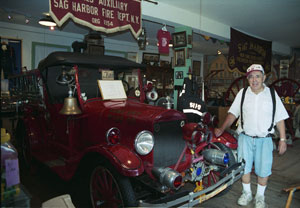Fire Museum, Where the Stories Abound

Stroll Sag Harbor's Main Street and you might happen upon an elderly man selling T-shirts, trinkets, a rubber ducky wearing a fireman's hat, and more in front of the Sag Harbor Fire Department.
Tom Horn Sr., a former chief and a volunteer fireman for 54 years, sets up shop on evenings in the summer, selling the souvenirs and small gifts to tourists, especially, to raise money for the department's Fireman Museum.
The museum, which opened in 1978, is in a building that dates to 1833 on the corner of Sage and Church Streets a few blocks away from the village's busy Main Street. The two-story structure was built to hold parish meetings and Sunday school for the Old Whalers Church, which at the time was in a building across the street.
Mr. Horn has dedicated much time and energy to the museum since its inception. "I enjoy the history of the village," he said recently while standing amid the museum's artifacts, which include a 1926 Model-T fire chief's pickup truck, donated in 1998 by the Archi family, and a hand-pulled hose cart used in the 1800s - pulled by men, not animals, Mr. Horn said.
The village's Fire Department is one of the oldest in New York State, having received its charter on March 26, 1803. The department bought its first piece of motorized equipment in 1913, and after a lot of training and time spent getting used to it, Mr. Horn said, the department became completely motorized seven years later.
During the summer, he opens the museum from 11 a.m. to 4 p.m. every day. The amount of time he spends there and vending on Main Street does not phase him, he said, as he doesn't consider his hours volunteering to be work.
Mr. Horn said teaching and retelling history excites him, especially when it is "the history of the village from a different direction." The museum's contents offer "a different perspective about life in the village after whaling was long gone."
Two young children, their parents, and an uncle ventured into the museum on a Friday afternoon. As Mr. Horn gave the tour, his voice carried over those of the chatty youngsters, and he showed no sign of annoyance at an uninterested parent text-messaging on a cellphone. Instead, he captured the children's attention with an invitation to ring the old bell. And he got the parents to listen with anecdotes. For example, if volunteers "didn't show up with a bucket . . . they were fined 50 cents."
A lifelong village resident, Mr. Horn knows quite a bit about his hometown. In particular, he said, he knows so much because "I listened to people talk." Also, his father, Thomas Horn, was a longtime member of the Gazelle Hose Company, and his mother, Anna Horn, was, in 1954, a charter member of the Ladies Auxiliary. Mr. Horn's son, Tom Horn Jr., is an honorary member of the Fire Department.
Various pictures, including one of his mother with her fellow charter members and his father with his company, decorate the museum's two floors. An enormous collection of antique trophies lines the shelves. There are firemen's patches and old booklets, including the first volunteer firemen's training manual to be published by the Suffolk County Board of Supervisors.
The building was home to the Montauk Hose Company for more than 80 years, until the company moved to the Brick Kiln Road complex on Columbia Street in 1976. Restored soon after, the museum's large doors that open on Sage Street are reminiscent of the garage doors on an old firehouse.
Before it was a firehouse, Mr. Horn said, the building served as the village hall and the village's first jail - an iron cell remains. Though it was a schoolhouse from 1866 to 1871, the school moved and became the Union School in what is now the Municipal Building. The village has owned the museum, which covers most of its small lot, since 1856.
A walk through the museum is a lesson in technological advances. Loudspeakers, trumpets, an air horn used from the 1920s to the early 1990s, alarm bells, and an old portable radio are all on display. A potbellied wood stove, used by volunteers to keep warm during cold winter nights while waiting for the call, is tucked away in a corner. A replica of a drying tower for linen hoses, which needed to be hung to dry to avoid rot, is on the second floor.
Mr. Horn has something to say about each item in the museum. He jokingly asked if a visitor knew what they did with a shiny silver foreman's trumpet, awarded to a Gazelle Company member in 1853. "They yelled at you!"
What he called a "true" 1876 centennial American flag hangs on a museum wall. It was donated by a onetime fire chief, but Mr. Horn wouldn't reveal who. "He never told me where he got it, because he probably shouldn't have gotten it!"
The museum gets 3,000 to 5,000 visitors a summer, ranging from out-of-town groups on bus tours to children whose parents bring them in on rainy days to watch fire prevention videos. Those under 10 years old are admitted free; admission for older children costs 50 cents. Adults are charged $1.
Whatever the age of the visitors, Mr. Horn said he enjoys taking them back into Sag Harbor's past.
What item he likes to show off the most is debatable. But if you ask him to show you the antique toy fire truck collection, which includes a few he played with as a child, you're sure to get a smile and a good story from the former chief.
